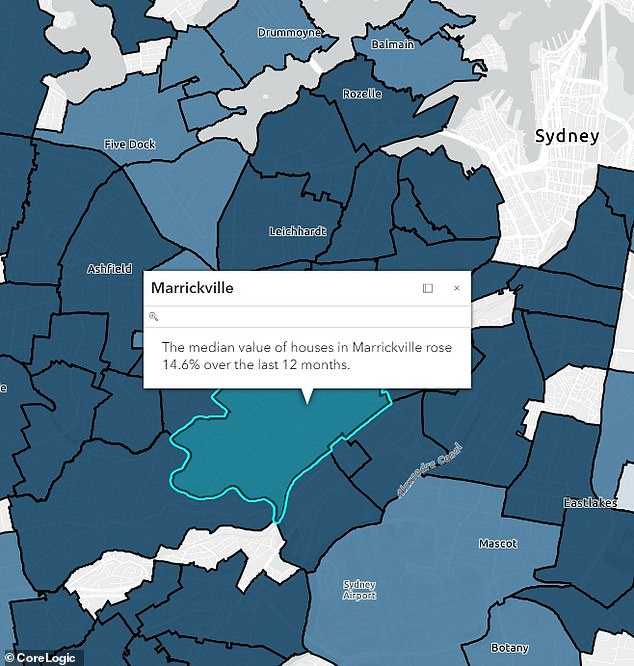How Anthony Albanese is personally benefiting from surging house prices in Sydney: His investment properties are revealed
Prime Minister Anthony Albanese owns two homes in inner-city suburbs that have been enjoyed Sydney's strongest real estate price growth during a housing crisis.
Marrickville, in the city's gentrified inner west, saw the average house price rise 14.6 per cent in the year to November to an even more unaffordable $2,022,621, new data from CoreLogic showed.
Mr Albanese owns a house in the suburb and lived there until he moved full-time to The Lodge in Canberra after winning the May 2022 election.
His register of pecuniary interest shows he owns three properties, including the house in Marrickville, along with an investment house in neighboring Dulwich Hill, which is rented out, and a unit in Canberra.
In Dulwich Hill, house prices have risen 19.7 per cent in the past year to $2,159,368, meaning the Prime Minister would benefit from capital growth as an investor-landlord.
A CoreLogic analysis found that Marrickville, Sydenham and Petersham, in Mr Albanese's Grayndler electorate, had the strongest annual price growth of 14.4 per cent in Sydney in November, taking average values for houses and units together. $1,694,355.
Prime Minister Anthony Albanese owns two homes in the inner-city suburbs that have seen Sydney's strongest property price growth during a housing crisis – including Marrickville (pictured) where prices have risen 14.6 per cent in the past year
Sydney's inner west was once a working-class area, but now average house prices are typically well above the $2 million mark, which is significantly more expensive than Sydney's average house price of $1,397,366.
Mr Albanese grew up locally in a housing council flat in Camperdown and was raised by his single mother on a disability pension, Maryanne.
In Sydney, Australia's most expensive capital, house prices have risen 11.5 percent in the past year, and 12.5 percent since hitting a low in January 2023.
This also coincided with Sydney's rental vacancy rate falling to an ultra-low 1.2 per cent, as 429,580 overseas migrants, on a net basis, moved to Australia in the year to September.
AMP chief economist Shane Oliver said the strongest population growth since the early 1950s meant house prices would continue to rise in 2023 despite aggressive interest rate increases.
“The supply shortage in the face of strong immigration has peaked this year and should prevent sharp price falls, but high interest rates and their delayed impact are now starting to reassert themselves,” he said.
House prices rose in Sydney, Brisbane, Adelaide, Perth and Canberra in November, even as the Reserve Bank last month raised rates for the 13th time in 18 months, taking the cash rate to a 12-year high of 4.35 per cent.
But in Melbourne, prices held steady at $943,725, in a city where annual house price growth of 3.3 per cent is much weaker than other major capitals.
Perth, Australia's most affordable capital, which benefits more from interstate than overseas migration, saw the strongest monthly growth of two per cent, while prices rose 13.8 per cent over the year to $676,910.
But in Aramadale in the city's southeast, prices rose at an annual rate of 21.5 percent to $551,197.
Outside of Perth and the coastal satellite city of Mandurah, Sydney's suburbs experienced the strongest property price growth in Australia.
The Warringah area, which covers Dee Why north of Manly on Sydney's northern beaches, saw an annual increase of 14.3 per cent, taking the average house and unit price to $2,067,881.
In Baulkham Hills, in Sydney's northwest, house prices rose 14.1 per cent to $2,021,885.
Less expensive areas also rose, with prices in Blacktown in the city's west rising 13.7 per cent to $970,316.
CoreLogic research director Tim Lawless said house price growth in wealthier suburbs was likely to slow as interest rate rises limited what banks could lend.
“The higher end of the market tends to lead the cycles in these cities,” he said.

Marrickville, in the city's inner west, saw the average house price rise 14.6 per cent in the year to November to an even more unaffordable $2,022,621, new data from CoreLogic shows.
'As borrowing capacity declines, we may see more demand shift to lower house prices, with the broad middle of the market now recording the strongest growth rates in Sydney and Melbourne.'
Labor lost the 2019 election under former leader Bill Shorten, who had campaigned on ending negative tax breaks for landlords for future purchases of investment properties, and halving the capital gains tax credit for investors from 50 to 25 percent.
Mr Albanese dumped these policies after taking over the Labor leadership, following a strong swing against Labor in the suburbs and regional areas, but not in the wealthy inner-city areas.
Ny Breaking Australia has contacted the Prime Minister's Office for comment.
